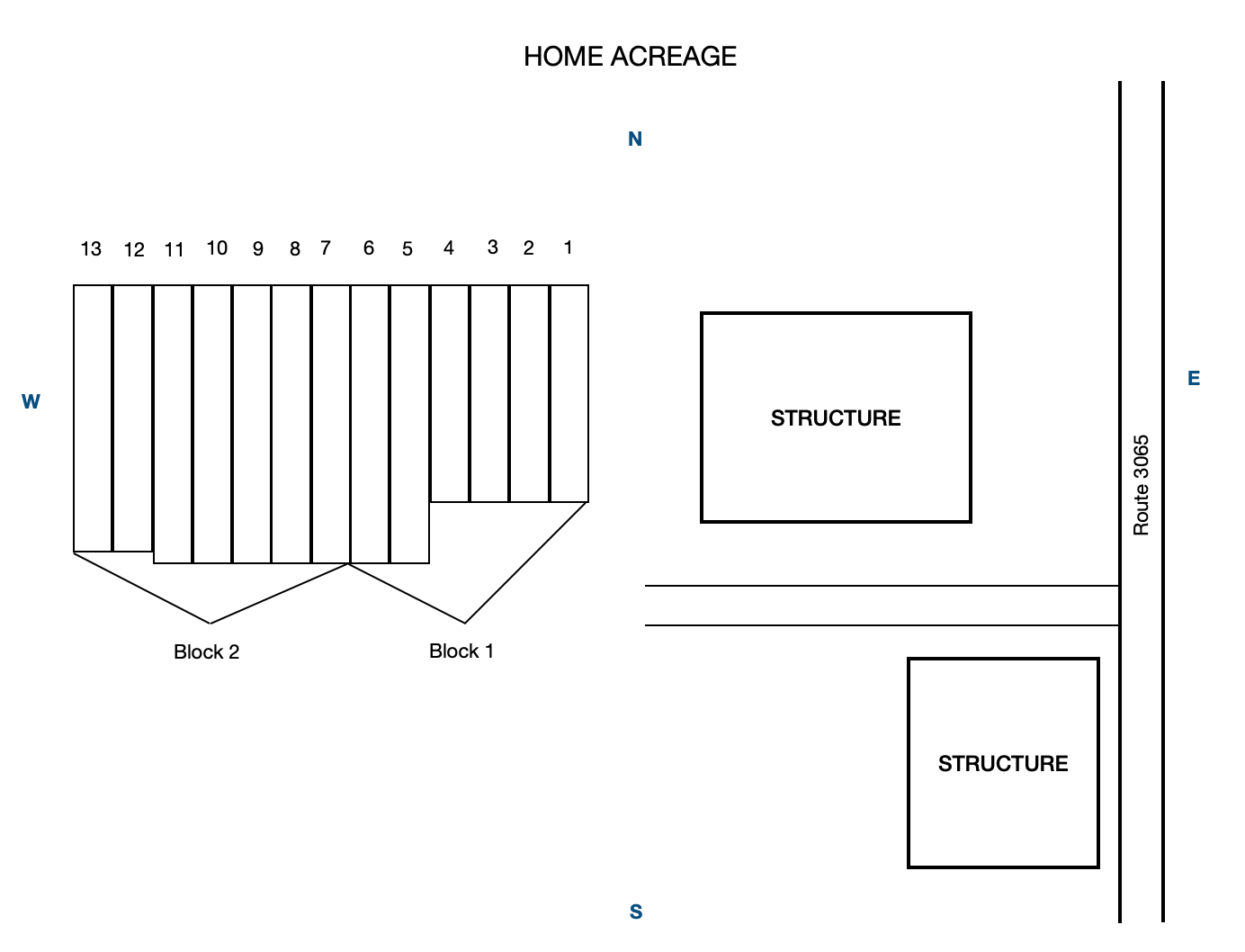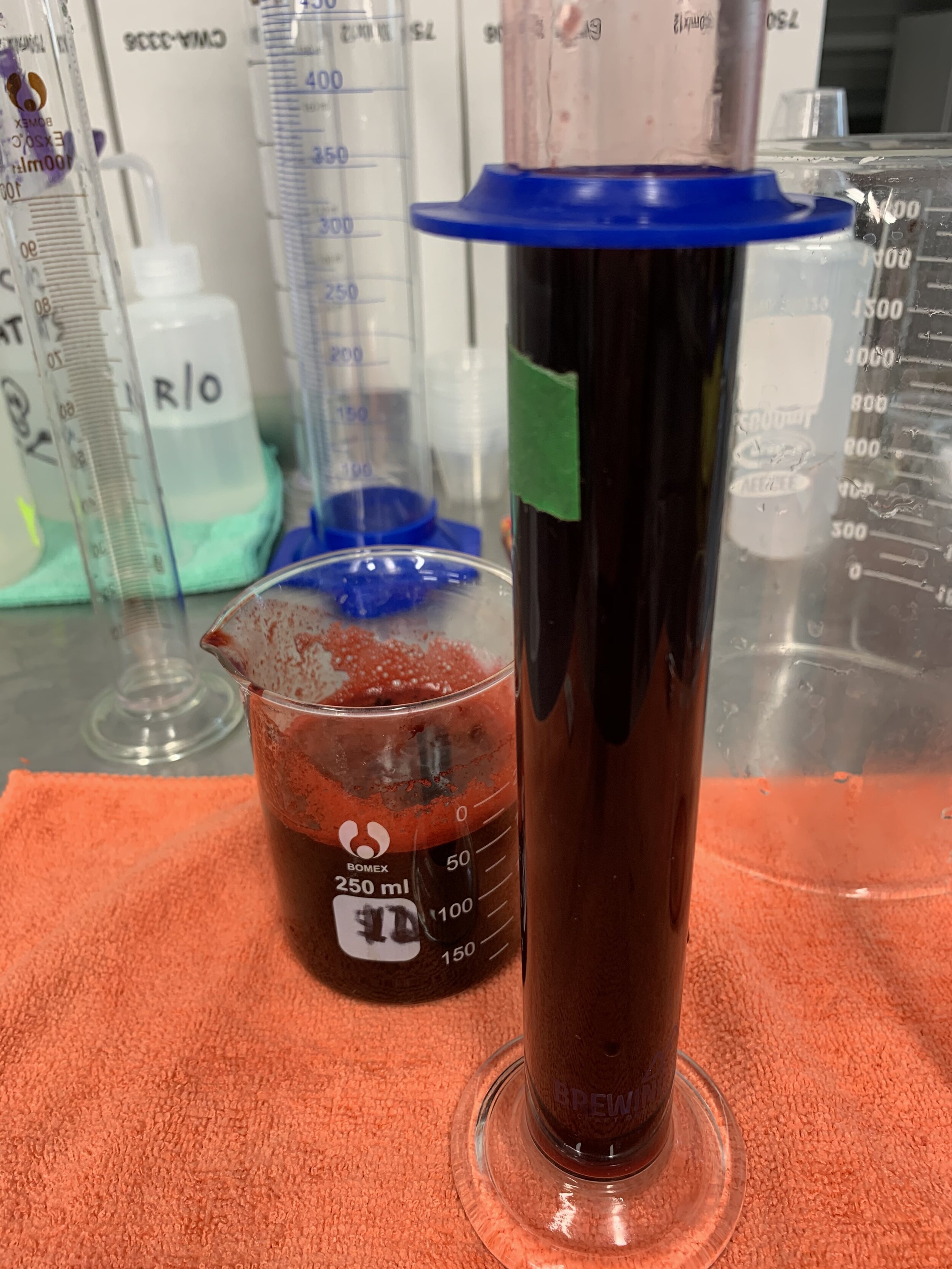How Do We Know When the Berries Are Ready for Harvest?
Winemakers who are responsible for deciding the harvest date of a vineyard rely on visual, taste, aroma and chemical parameters to optimize the fruit for the style of wine they plan to make. Since we grow our own fruit for our wines, we have the pleasure of sampling and making such decisions in a more leisurely fashion.
Currently, our orchards are divided into 6 “blocks”.
Optimally, I would take a representative sample from each block every day or two; then examine, taste and chemically analyze. Treatment of all test samples is identical:
handpicked at random intervals throughout the block, including sun sides and shaded sides, top and bottom of random plants
washed gently in cool water, air dried, and frozen 24 hours in a ziploc™ bag
crushed and treated with pectinase and glucosidases (aka enzymes) as per wine protocol (allowed to macerate for 6 hours)
pressed for juice.
Brix, pH, and TA (titratable acidity) are measured and colour and aroma assessed
ratio of 35-40 percent juice and 60-65 percent water with Brix adequate to obtain a final Brix of 20.5 to 22.0
assessed again for colour, pH, TA, taste and aroma
Block 1: Home Acre Indigo Gem and Berry Blue: with a 4:1 ratio 7 rows 45-65 plants each 7 years old
Sample 1: July 8, 2020
Weight 360 g: Brix was 12.5, pH 3.0, pH and TA more acidic still; the decision was made to wait 3 more days and test again as the Brix was not ideal, and the product still a little acidic and tart for wine, although these kinds of berries make excellent jam and toppings! One procedure we follow when testing berries for ripeness is cutting them open and looking for solid red/indigo colour throughout plus assessment of the seed maturity. In this sample you can see that the berries aren’t optimally ripe; if they were, they would not have any red spots and the colour would be indigo blue throughout.
Sample 2: July 11, 2020:
Weight 360 g: Brix was 13, pH 3.1, less acidic. Again, we need to wait a little longer. Berries definitely tasting sweeter and looking riper.
Sample 3: July 13, 2020
Weight 360 g (left sample), the right is another sample from Block 3a. You can already see that the colour is deeper and more uniformly indigo blue. This sample has a Brix of 14 and is indicative of being nearly ready for harvest. The taste is optimal and the colour of the cut berry is also uniformly ripe. The seeds are starting to look ripe as well. We will be starting Block 1’s harvest on July 15.
Block 2: Home Acre Tundra and Berry Blue: with a 4:1 ratio 6 rows of 65 plants each 7 years old
Sample 1: July 13, 2020
The Brix of each sample is checked, along with other parameters to determine suitable harvest time. During the lab assessment, the dilution ratio of each sample to provide optimal product to ferment is established. For example, this sample was diluted 35% Brix 14.2 juice, with 65% Brix 26 water (sugar added) and the pH, TA, and taste/aroma were determined to be optimal.
For example, if I want a final Brix of 21, I would make my water at Brix
(35 x 14.2) + (65 x X) divided by 100 = 21
X = Brix of 26
Sample 2: July 15, 2020
Block 3a: North Orchard Indigo Gem and Berry Blue, some Smart Berry Blue and some Aurora: 12 rows, 8 with 205-10 plants each and 4 with 120-170 plants each, the South 50 plants of Rows 13 to 20 are also included since they are prone to both drought and flooding and are more stressed than Block 3b. Most are 5 years old, some younger at the roadside (4 years old); some mole damage and susceptible to flooding or drought and wind. Seems to ripen more quickly. Considerable weed pressure in this block too. General stress.
Sample 1: July 13, 2020
Sample 2: July 15, 2020
The second sample indicated this block was ready for harvest on the 15th, with a Brix of nearly 15.
Block 3b: North Orchard Indigo Gem and Berry Blue, some Smart Berry Blue and some Aurora: 4 rows mature 6 and 7 years old, 210 plants each. North 155 plants of Rows 13 to 20. Healthier and protected from the wind. Seems to ripen less quickly than 3a, but more quickly than Block 4 (which is primarily Tundra and later anyway). Less weed pressure and healthier plants than Block 3a. Some boron deficiency noted.
Sample 1: July 13, 2020
Sample 2: July 15, 2020
The second sample indicated this block was ready for harvest on the 15th, with a Brix of nearly 15.
Block 4a: North Orchard Tundra and Berry Blue, some Smart Berry Blue and some Aurora. Healthy, protected and stress-free plants. First 12 rows, and North half of last 10 rows. Mostly mature 6 and 7 year olds. Some evidence of boron deficiency. Little stress otherwise.
Sample 1: July 14, 2020
Sample 2: July 16, 2020
The second samples were more than ready to harvest, at a Brix of nearly 15, and definitely great colour throughout the berry.
Block 4b: North Orchard Tundra and Smart Berry Blue, more Aurora here. This area is the top of the hillside South of Rows 13-22, which had drought stress in the first 3 years, although is currently thriving. Plants are mostly 5 or 6 years old and now healthy, with the area of the hill having better drainage in this rainy season of 2020. Some evidence of boron deficiency.
Sample 1: July 15, 2020
Sample 2: July 17, 2020
Again, samples were done as indicated. We then got busy with harvest and, with the final samples, decided the order of harvest.
Check out our 2020 harvest video.
It was a good exercise, and with the sample notes in hand, it was easy to decide which blocks to harvest first. We also label buckets with block numbers and areas so that we can plan ahead for additions and correct winemaking decisions which will optimize the flavour, aroma and profile of each batch according to the berries we harvested.





